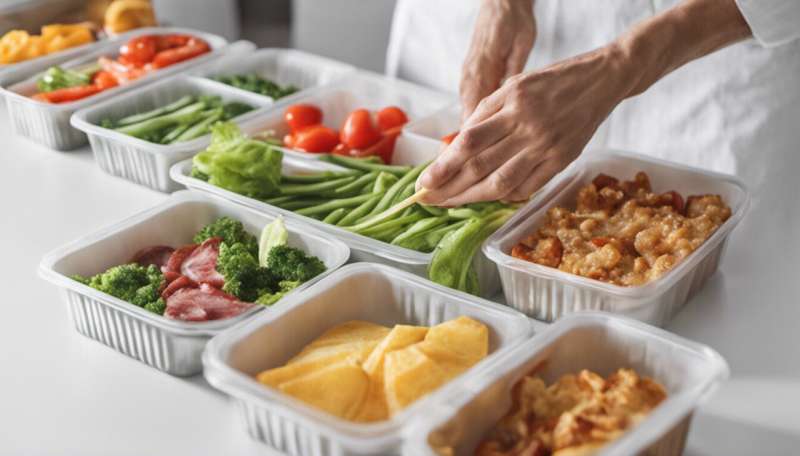Tips for taking the pain out of packing school lunch boxes

School starts across most of Australia this week, so parents and carers are breaking out the lunch boxes once again. For some, preparing food that kids will want to eat can become something of a dreaded chore over time, so here are some suggestions to keep both you and the kids interested in nutritious packed lunches.
The ideal lunch box should hold enough food to keep a child nourished during the day, and for most primary school-aged kids, this means a snack as well as lunch.
Many schools also have "brain food" or "fruit snack" time, when children can eat fruit or vegetables in the classroom, so this needs to be prepared as well. The only drink you need to provide is water.
A healthy mix
Lunch should include some carbohydrate-based food for energy, such as bread (in slices or a roll), wraps, crackers, pasta or rice – in some form or another.
It's a good idea to try to include some protein such as meat, chicken, fish, eggs, cheese, or yoghurt. And one or two servings of fruit or vegetables will provide vitamins and minerals as well as energy.
For young children, fruit can be presented in ready-to-eat pieces in small containers or snap-lock bags. Cubes of watermelon or rockmelon, chunks of kiwi fruit, orange quarters, small bunches of grapes are some easy options.
Vegetables that are easy to take to school are cherry tomatoes, mini cucumbers or cucumber sticks, carrot and celery sticks, snow peas and so on. These can be packed with a dip, such as hummus or tzatziki.
Tasty snacks
The mid-morning snack can be cheese and biscuits, or a small treat such as a fruit-based muffin, some oat-based biscuits, such as Anzacs, or a wholegrain muesli bar.
A word of warning about these snacks. Supermarkets carry an enormous range of commercial "lunch box snacks" but many are not good choices because they contain a lot of fat and sugar. Be sure to read labels before buying, and select those containing less than 600 kilojoules per serve; around ten grams or less of sugar per 100 grams; and five grams or less of fat for every 100 grams.
It's important to keep in mind that commercial foods come with a large amount of packaging that can be difficult for small hands to manage. They also create a large amount of rubbish, and many schools have a "nude food" policy that disallows packaging and encourages reusable containers.
A homemade apple muffin, pikelets or Anzac biscuits will provide the right nutrition mix and the environmentally-friendly criteria. Make a batch during the weekend to have something special for the week's lunchbox, as well as having some fun together practicing maths and chemistry skills when cooking.
The importance of keeping cool
Nutrition is not the only matter of concern when it comes to lunch boxes, you also need to ensure that the food you've prepared is safe for consumption by the time it's eaten.
Few schools have refrigeration facilities for children's lunches so you need to consider keeping the food cool. An ice brick or frozen water bottle will help keep the temperature at a level that's safe for food.
Some children have to leave schoolbags on pegs outside the classroom, so during summer months, you might have to advocate to allow lunches to be brought inside at the beginning of the day.
A small project by the NSW Food Authority found less than a third of children brought an ice brick in their lunchboxes and that many had foods that would not be safe at room temperature for extended time periods. They also found bacteria counts in lunches increased 14-fold in lunches without frozen drinks, and that they were about 12ᵒ Celsius warmer than those with ice bricks within a few hours.
Creating good habits
Despite your best efforts, children will come home with food left in their lunch boxes. It's a good idea to get them to empty the lunch box when they get home, and leftovers might even make a good after-school snack. There are many reasons why children might not eat – because they're not hungry, because they're too busy, or because the food might take too long to eat.
Getting kids in the habit of taking their lunch boxes into the kitchen straight after school means you can wash them and start filling them for the next day while preparing dinner.
Making lunch is part of being a parent, at least during primary school years, but it can be exhausting to come up with tasty treats every day. You can find good suggestions and recipes for lunches on various websites such as here and here.
Planning what foods to include for the week, cooking a little extra dinner for leftovers, having enough favoured fillings, and fruit and vegetables as well as baking healthy snacks all make the job easier.
And in response to the inevitable "everyone-else-has-chips-in-their-lunch-box" whine, you can borrow the standard answer I've used for the 14 years I've been filling lunch boxes – "that may be so!"
This story is published courtesy of The Conversation (under Creative Commons-Attribution/No derivatives).
![]()



















